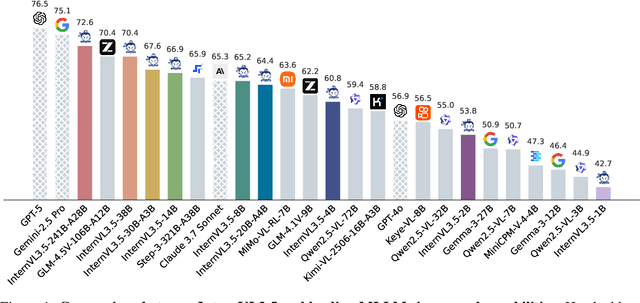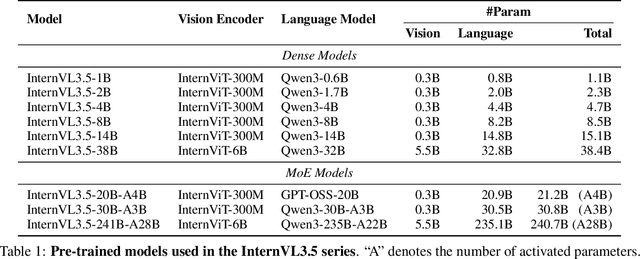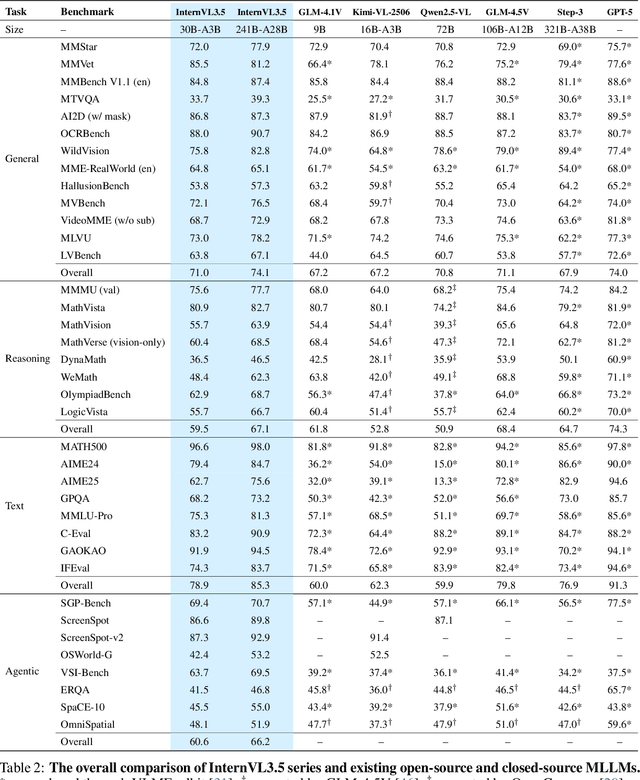Xingguang Wei
InternVL3.5: Advancing Open-Source Multimodal Models in Versatility, Reasoning, and Efficiency
Aug 25, 2025



Abstract:We introduce InternVL 3.5, a new family of open-source multimodal models that significantly advances versatility, reasoning capability, and inference efficiency along the InternVL series. A key innovation is the Cascade Reinforcement Learning (Cascade RL) framework, which enhances reasoning through a two-stage process: offline RL for stable convergence and online RL for refined alignment. This coarse-to-fine training strategy leads to substantial improvements on downstream reasoning tasks, e.g., MMMU and MathVista. To optimize efficiency, we propose a Visual Resolution Router (ViR) that dynamically adjusts the resolution of visual tokens without compromising performance. Coupled with ViR, our Decoupled Vision-Language Deployment (DvD) strategy separates the vision encoder and language model across different GPUs, effectively balancing computational load. These contributions collectively enable InternVL3.5 to achieve up to a +16.0\% gain in overall reasoning performance and a 4.05$\times$ inference speedup compared to its predecessor, i.e., InternVL3. In addition, InternVL3.5 supports novel capabilities such as GUI interaction and embodied agency. Notably, our largest model, i.e., InternVL3.5-241B-A28B, attains state-of-the-art results among open-source MLLMs across general multimodal, reasoning, text, and agentic tasks -- narrowing the performance gap with leading commercial models like GPT-5. All models and code are publicly released.
DeCo-SGD: Joint Optimization of Delay Staleness and Gradient Compression Ratio for Distributed SGD
Jul 23, 2025Abstract:Distributed machine learning in high end-to-end latency and low, varying bandwidth network environments undergoes severe throughput degradation. Due to its low communication requirements, distributed SGD (D-SGD) remains the mainstream optimizer in such challenging networks, but it still suffers from significant throughput reduction. To mitigate these limitations, existing approaches typically employ gradient compression and delayed aggregation to alleviate low bandwidth and high latency, respectively. To address both challenges simultaneously, these strategies are often combined, introducing a complex three-way trade-off among compression ratio, staleness (delayed synchronization steps), and model convergence rate. To achieve the balance under varying bandwidth conditions, an adaptive policy is required to dynamically adjust these parameters. Unfortunately, existing works rely on static heuristic strategies due to the lack of theoretical guidance, which prevents them from achieving this goal. This study fills in this theoretical gap by introducing a new theoretical tool, decomposing the joint optimization problem into a traditional convergence rate analysis with multiple analyzable noise terms. We are the first to reveal that staleness exponentially amplifies the negative impact of gradient compression on training performance, filling a critical gap in understanding how compressed and delayed gradients affect training. Furthermore, by integrating the convergence rate with a network-aware time minimization condition, we propose DeCo-SGD, which dynamically adjusts the compression ratio and staleness based on the real-time network condition and training task. DeCo-SGD achieves up to 5.07 and 1.37 speed-ups over D-SGD and static strategy in high-latency and low, varying bandwidth networks, respectively.
Point or Line? Using Line-based Representation for Panoptic Symbol Spotting in CAD Drawings
May 29, 2025Abstract:We study the task of panoptic symbol spotting, which involves identifying both individual instances of countable things and the semantic regions of uncountable stuff in computer-aided design (CAD) drawings composed of vector graphical primitives. Existing methods typically rely on image rasterization, graph construction, or point-based representation, but these approaches often suffer from high computational costs, limited generality, and loss of geometric structural information. In this paper, we propose VecFormer, a novel method that addresses these challenges through line-based representation of primitives. This design preserves the geometric continuity of the original primitive, enabling more accurate shape representation while maintaining a computation-friendly structure, making it well-suited for vector graphic understanding tasks. To further enhance prediction reliability, we introduce a Branch Fusion Refinement module that effectively integrates instance and semantic predictions, resolving their inconsistencies for more coherent panoptic outputs. Extensive experiments demonstrate that our method establishes a new state-of-the-art, achieving 91.1 PQ, with Stuff-PQ improved by 9.6 and 21.2 points over the second-best results under settings with and without prior information, respectively, highlighting the strong potential of line-based representation as a foundation for vector graphic understanding.
InternVL3: Exploring Advanced Training and Test-Time Recipes for Open-Source Multimodal Models
Apr 15, 2025Abstract:We introduce InternVL3, a significant advancement in the InternVL series featuring a native multimodal pre-training paradigm. Rather than adapting a text-only large language model (LLM) into a multimodal large language model (MLLM) that supports visual inputs, InternVL3 jointly acquires multimodal and linguistic capabilities from both diverse multimodal data and pure-text corpora during a single pre-training stage. This unified training paradigm effectively addresses the complexities and alignment challenges commonly encountered in conventional post-hoc training pipelines for MLLMs. To further improve performance and scalability, InternVL3 incorporates variable visual position encoding (V2PE) to support extended multimodal contexts, employs advanced post-training techniques such as supervised fine-tuning (SFT) and mixed preference optimization (MPO), and adopts test-time scaling strategies alongside an optimized training infrastructure. Extensive empirical evaluations demonstrate that InternVL3 delivers superior performance across a wide range of multi-modal tasks. In particular, InternVL3-78B achieves a score of 72.2 on the MMMU benchmark, setting a new state-of-the-art among open-source MLLMs. Its capabilities remain highly competitive with leading proprietary models, including ChatGPT-4o, Claude 3.5 Sonnet, and Gemini 2.5 Pro, while also maintaining strong pure-language proficiency. In pursuit of open-science principles, we will publicly release both the training data and model weights to foster further research and development in next-generation MLLMs.
ArchCAD-400K: An Open Large-Scale Architectural CAD Dataset and New Baseline for Panoptic Symbol Spotting
Apr 02, 2025Abstract:Recognizing symbols in architectural CAD drawings is critical for various advanced engineering applications. In this paper, we propose a novel CAD data annotation engine that leverages intrinsic attributes from systematically archived CAD drawings to automatically generate high-quality annotations, thus significantly reducing manual labeling efforts. Utilizing this engine, we construct ArchCAD-400K, a large-scale CAD dataset consisting of 413,062 chunks from 5538 highly standardized drawings, making it over 26 times larger than the largest existing CAD dataset. ArchCAD-400K boasts an extended drawing diversity and broader categories, offering line-grained annotations. Furthermore, we present a new baseline model for panoptic symbol spotting, termed Dual-Pathway Symbol Spotter (DPSS). It incorporates an adaptive fusion module to enhance primitive features with complementary image features, achieving state-of-the-art performance and enhanced robustness. Extensive experiments validate the effectiveness of DPSS, demonstrating the value of ArchCAD-400K and its potential to drive innovation in architectural design and construction.
Flexible Spectrum Orchestration of Carrier Aggregation for 5G-Advanced
May 25, 2023Abstract:With increasing availability of spectrum in the market due to new spectrum allocation and re-farming bands from previous cellular generation networks, a more flexible, efficient and green usage of the spectrum becomes an important topic in 5G-Advanced. In this article, we provide an overview on the 3rd Generation Partnership Project (3GPP) work on flexible spectrum orchestration for carrier aggregation (CA). The configuration settings, requirements and potential specification impacts are analyzed. Some involved Release 18 techniques, such as multi-cell scheduling, transmitter switching and network energy saving, are also presented. Evaluation results show that clear performance gain can be achieved by these techniques.
 Add to Chrome
Add to Chrome Add to Firefox
Add to Firefox Add to Edge
Add to Edge